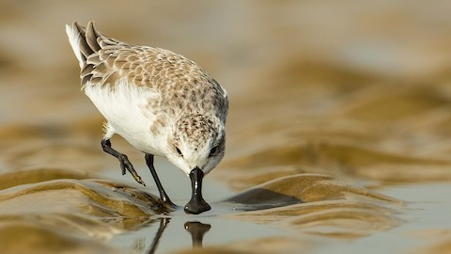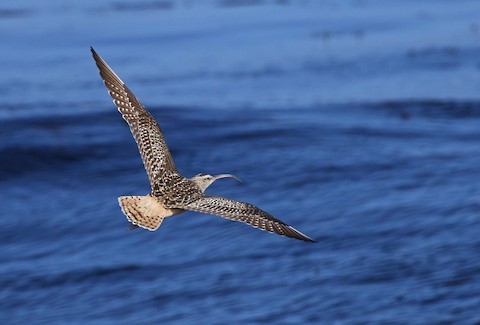Scolopacidae: Sandpipers
Most sandpipers, like most humans, are drawn to beaches. A few widespread species such as the Sanderling (Calidris alba) and Ruddy Turnstone (Arenaria interpres) can be found on picturesque coastlines nearly worldwide, and are globally familiar. But the majority of sandpiper species prefer extensive mudflats, where they congregate in large, usually mixed flocks that rarely tolerate the close approach of a human or any other potential predator, and are therefore much less familiar.
Sandpipers are famously migratory, most nesting on arctic tundra or other boreal wetlands and spending most of the year vacationing in the south. A few species make direct flights of several thousand miles. Prominent examples include populations of Bar-tailed Godwit (Limosa lapponica) flying between Siberia and New Zealand, Red Knot (Calidris canutus) between Nunavut and Patagonia, and Bristle-thighed Curlew (Numenius tahitiensis) between western Alaska and southern Polynesia.
The family also includes two atypical groups with divergent life histories. The phalaropes are primarily aquatic, with two of the three species being largely marine and spending the bulk of each year far offshore. A larger group, the woodcocks and snipes, includes many species that prefer moist interior habitats, and several that are sedentary and inhabit only a few isolated bogs and swamps.
Identification
Most sandpipers belong to a group of similar species, often with significant geographical overlap among them, especially during migration. Within some species groups, accurate identification can be extremely challenging and may require vocal confirmation for absolute certainty.
As most sandpiper species are highly migratory, they have the ability to travel almost anywhere, so they can occur far from their normal ranges and blend into crowds of similar species. Long-distance vagrancy is frequent enough among sandpipers that an attentive birdwatcher on a coast is reasonably likely to find a few lost sandpipers per season—which makes this family a special favorite of those who enjoy recreational bird identification.
Taxonomy
As currently understood, the Scolopacidae consists of five major lineages that are widely regarded as subfamilies:
Numeniinae: Curlews (7 to 10 species, plus 2 extinct)
Limosinae: Godwits (4 to 6 species)
Arenariinae: Stints (27 species, plus 3 extinct)
Tringinae: Shanks and phalaropes (19 to 20 species)
Scolopacinae: Woodcocks and snipes (32 to 33 species, plus 2 extinct)
Species-level classification of sandpipers is mostly stable, with a handful of exceptions: the Whimbrels, the Old World godwits, the Willets, and the South American snipes. The resulting count rests somewhere between 89 and 96 species, plus 7 extinct.
Upland Sandpiper (Bartramia longicauda)
Bristle-thighed Curlew (Numenius tahitiensis)
Whimbrel (Numenius phaeopus)
“European Whimbrel” (N. p. phaeopus)
“Steppe Whimbrel” (N. p. alboaxillaris)
“Siberian Whimbrel” (N. p. variegatus)
“American Whimbrel” (N. p. husonicus)
Little Curlew (Numenius minutus)
Eskimo Curlew (Numenius borealis) †
Long-billed Curlew (Numenius americanus)
Far Eastern Curlew (Numenius madagascariensis)
Slender-billed Curlew (Numenius tenuirostris) †
Eurasian Curlew (Numenius arquata)
Bar-tailed Godwit (Limosa lapponica)
“Lapland Godwit” (L. l. lapponica)
“Bauer’s Godwit” (L. l. baueri)
Black-tailed Godwit (Limosa limosa)
“Western Black-tailed Godwit” (L. l. limosa)
“Eastern Black-tailed Godwit” (L. l. melanuroides)
Hudsonian Godwit (Limosa haemastica)
Marbled Godwit (Limosa fedoa)
Ruddy Turnstone (Arenaria interpres)
Black Turnstone (Arenaria melanocephala)
Tuamotu Sandpiper (Prosobonia parvirostris)
Kiritimati Sandpiper (Prosobonia cancellata) †
Tahiti Sandpiper (Prosobonia leucoptera) †
Moorea Sandpiper (Prosobonia ellisi) †
Great Knot (Calidris tenuirostris)
Red Knot (Calidris canutus)
Surfbird (Calidris virgata)
Ruff (Calidris pugnax)
Broad-billed Sandpiper (Calidris falcinellus)
Sharp-tailed Sandpiper (Calidris acuminata)
Stilt Sandpiper (Calidris himantopus)
Curlew Sandpiper (Calidris ferruginea)
Temminck’s Stint (Calidris temminckii)
Long-toed Stint (Calidris subminuta)
Spoon-billed Sandpiper (Calidris pygmea)
Red-necked Stint (Calidris ruficollis)
Sanderling (Calidris alba)
Dunlin (Calidris alpina)
Rock Sandpiper (Calidris ptilocnemis)
Purple Sandpiper (Calidris maritima)
Baird’s Sandpiper (Calidris bairdii)
Little Stint (Calidris minuta)
Least Sandpiper (Calidris minutilla)
White-rumped Sandpiper (Calidris fuscicollis)
Buff-breasted Sandpiper (Calidris subruficollis)
Pectoral Sandpiper (Calidris melanotos)
Semipalmated Sandpiper (Calidris pusilla)
Western Sandpiper (Calidris mauri)
Terek Sandpiper (Xenus cinereus)
Wilson’s Phalarope (Phalaropus tricolor)
Red-necked Phalarope (Phalaropus lobatus)
Red Phalarope (Phalaropus fulicarius)
Common Sandpiper (Actitis hypoleucos)
Spotted Sandpiper (Actitis macularius)
Green Sandpiper (Tringa ochropus)
Solitary Sandpiper (Tringa solitaria)
Wandering Tattler (Tringa incana)
Gray-tailed Tattler (Tringa brevipes)
Lesser Yellowlegs (Tringa flavipes)
Willet (Tringa semipalmata)
“Western Willet” (T. s. inornata)
“Eastern Willet” (T. s. semipalmata)
Common Redshank (Tringa totanus)
Marsh Sandpiper (Tringa stagnatilis)
Wood Sandpiper (Tringa glareola)
Spotted Redshank (Tringa erythropus)
Common Greenshank (Tringa nebularia)
Nordmann’s Greenshank (Tringa guttifer)
Greater Yellowlegs (Tringa melanoleuca)
Jack Snipe (Lymnocryptes minimus)
Asian Dowitcher (Limnodromus semipalmatus)
Long-billed Dowitcher (Limnodromus scolopaceus)
Short-billed Dowitcher (Limnodromus griseus)
Eurasian Woodcock (Scolopax rusticola)
Amami Woodcock (Scolopax mira)
Javan Woodcock (Scolopax saturata)
New Guinea Woodcock (Scolopax rosenbergii)
Bukidnon Woodcock (Scolopax bukidnonensis)
Sulawesi Woodcock (Scolopax celebensis)
Moluccan Woodcock (Scolopax rochussenii)
American Woodcock (Scolopax minor)
Andean Snipe (Chubbia jamesoni)
Fuegian Snipe (Chubbia stricklandii)
Imperial Snipe (Chubbia imperialis)
Chatham Snipe (Coenocorypha pusilla)
North Island Snipe (Coenocorypha barrierensis) †
Subantarctic Snipe (Coenocorypha aucklandica)
South Island Snipe (Coenocorypha iredalei) †
Snares Snipe (Coenocorypha huegeli)
Solitary Snipe (Gallinago solitaria)
Latham’s Snipe (Gallinago hardwickii)
Wood Snipe (Gallinago nemoricola)
Common Snipe (Gallinago gallinago)
Wilson’s Snipe (Gallinago delicata)
Pin-tailed Snipe (Gallinago stenura)
Swinhoe’s Snipe (Gallinago megala)
African Snipe (Gallinago nigripennis)
Madagascan Snipe (Gallinago macrodactyla)
Great Snipe (Gallinago media)
South American Snipe (Gallinago paraguaiae)
“Paraguayan Snipe” (G. p. paraguaiae)
“Magellanic Snipe” (G. p. magellanica)
Puna Snipe (Gallinago andina)
Noble Snipe (Gallinago nobilis)
Giant Snipe (Gallinago undulata)
References
Boyd, J.H., 2019. Taxonomy in Flux: Charadriiformes. http://jboyd.net/Taxo/List9a.html. (Posted August 2, 2019; Accessed July 3, 2020.)
Hayman, P., J. Marchant, and T. Prater. 1986. Shorebirds: An Identification Guide. Houghton Mifflin, Boston.
Hume, J.P. 2017. Extinct Birds (Second Edition). Bloomsbury Publishing PLC, London.
Roberson, D. 2004. Bird Families of the World: Sandpipers, Scolopacidae, http://creagrus.home.montereybay.com/sandpipers.html. (Posted August 20, 2004. Accessed July 3, 2020.)

